The Fish
Mid Atlantic Coastal Fish
At the North and South Carolina coast there are several different species and types of fish that you can catch from the pier. Below is a partial description of the most likely fish that are found in the coastal waters, in no particular order. Read the description for size, the images are not proportional. Not listed are sharks and dogfish that are a subspecies of shark.

American Shad
- American Shad are found along the Atlantic coast from Canada to central Florida.
- Size: 4 lbs, 16"- 20", Max size: 12 lbs, 24".
- Food Quality: Excellent but many small bones. The roe is considered a delicacy and featured in many low country restaurants.
- Angling: Taken on hook and line with artificial lures known as shad darts.
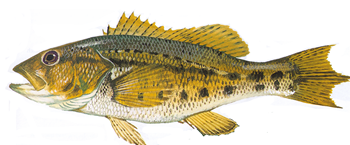
Bank Sea Bass
- Found offshore in 50 - 500 feet deep in hard bottom areas. Not normally caught from piers.
- Size: 1/2 - 1 lb, 6"- 8", Max size: 10.5".
- Food Quality: Good
- Angling: Bottom fishing with squid, live or cut baits.

Black Sea Bass
- Black Sea Bass is a bottom-dwelling species found around wrecks, reefs, piers and jetties.
- Size: 1-3lbs 10"- 12 " Max size: 9lbs. 19".
- Food Quality: Excellent
- Angling: Still & Drift bottom fishing with live and cut baits

Black Drum
- Inshore bottom fish favor sandy bottoms near jetties,, bridges, and pier pilings.
- Size: 2 -10 lbs. 14" - 24", Max size: 113 lb, 50".
- Food Quality: Good, less than 20lb. Larger fish frequently contain parasites.
- Angling: Caught with live and cut baits such as shrimp, crabs, clams, and mussels.

Bluback Herring
- Considered as bait fish and caught only for bait.
- Size: 1/3 lb, 10"- 12", Max size: 1 lb, 14".
- Food Quality: Poor Generally not eaten fresh. but rather pickled and smoked.

Bluefish
- Bluefish usually found in coastal shallow waters traveling in schools
- Size: 3 lbs., 10"- 20" , Max size: 41 lbs. 38"
- Food quality: Good. quickly become soft, does not keep or freeze well.
- Angling: Trolling and casting live and dead baits or jigging from pier.

Cutlass Fish (Ribbon Fish)
- Cutlass Fish or more commonly called Ribbon Fish are long slender fish with no scales. It is not an eel, it is a fish. It's skin is shiny metallic silver in color.
- Average Size: 1 lbs., 36", Max size: 3 lbs. 48"
- Food quality: Excellent, but not normally eaten in the US.
- Angling: Jigging, artificial crank baits and lures. Watch out for the long sharp teeth!

Cobia
- Cobia are usually found in shallow continental shelf waters around buoys, pilings, wrecks, anchored boats and other floating objects.
- Average Size: 15 lbs., 30"- 48", Max size: 150 lbs. 60"
- Food quality: Excellent. White solid flesh.
- Angling: Trolling, bottom fishing, jigging, casting live bait and lures. Use crabs, eels, squid and small fish.

Crevalle Jack
- Crevalle Jacks can be found in coastal waters, over inshore reefs, harbors and bays as well as in depths up to 130 feet.
- Average Size: 3 - 5 lbs., 18"-24", Max size: 55 lbs. 40"
- Food quality: Poor. Larger fish usually contain parasitic worms.
- Angling: casting or trolling live or artificial lures. as well as jigging off piers.

Florida Pompano
- Pompano are abundant in shallow coastal inshore water over sand and shell bottoms from June through October.
- Average Size: 1 - 3 lbs, 10"- 14", Max size: 7 lbs, 18"
- Food quality: Excellent fried, broiled or grilled.
- Angling: Caught in the surf along beaches, in shallow water and inlets bottom fishing or jigging from a pier.

Atlantic Croaker
- Croakers are bottom dwellers that make a croaking sound when handled. they preffer mud shell and sand bottoms.
- Average Size: 1 1/2 lbs., 8"-14", Max size: 5 lbs. 24"
- Food quality: Excellent
- Angling: live or cut bait at or near the bottom.

Ladyfish
- Ladyfish are inshore species occasionally caught off piers by jigging artificial lures. Also known as the ten pounder.
- Average Size: 2 - 3 lbs, 18"-24", Max size: 6 lbs, 36"
- Food quality: Poor, very bony not generally eaten.
- Angling: trolling or casting with natural or artificial bait. Hard fighters especially on light tackle.

Lizardfish
- Lizerdfish are inshore species frequently found in brackish waters.
- Average Size: 2 lbs, 10"- 14", Max size: 2 - 3 lbs, 16"
- Food quality: Poor, Not generally eaten.
- Angling: Bottom fishing with cut or live bait. Occasionally caught while jigging for Spanish Mackerel.

Oyster Toadfish
- Also just called toadfish, they are an inshore, bottom-dwelling fish.
- Average Size: 1 - 2 lbs, 8"- 12", Max size: 4.5 lbs, 14"
- Food quality: Poor, Not normally eaten.
- Angling: Caught while fishing for other fish. Handle with care due to strong jaws and sharp spines.

Pigfish
- Pigfish are found in coastal water over sandy and muddy bottoms.
- Average Size: 1/2 lbs, 6"- 8", Max size: 2 lbs, 12"
- Food quality: Fair, Released or used as bait.
- Angling: Using minnows, small jigs, grubs, worms usually caught while fishing for other types of fish.

Pinfish
- Pinfish are coastal or inshore species. that travel in schools. Usually found in rocky bottoms and around docks and pilings.
- Average Size: 1/4 lbs, 6"- 8", Max size: 2 lbs, 10"
- Food quality: Fair, Used as bait.
- Angling: Known as bait stealers. Watch for small spines on their fins that can stick your hands and fingers like pins or needles.

Red Drum
- Red Drum, also known as spot tail, redfish, or channel bass, are found mostly in May through October and prefer sand and muddy bottoms. .
- Average Size: 2 - 5 lbs, 12"- 24", Max size: 94 lbs, 60"
- Food quality: Excellent for fish less than 10 lbs. Larger fish may be coarse and carry parasites.
- Angling: Older and larger fish are caught
just beyond the breakers and in shallow waters with live or cut bait. Younger fish are caught using shrimp, mud minnows, jigs, plugs and spoons and usually found on flats

Rock Sea Bass
- Rock Sea Bass are found in 30 to 60 feet of water over muddy or sandy bottoms. Not normally caught from ocean piers.
- Average Size: 1 - 2 lbs, 6"- 8", Max size: 3 lbs, 10"
- Food quality: Good.
- Angling: Still or drift fishing with squid, live or cut baits.

Sheepshead
- Sheepshead prefer obstructions such as pilings, piers and rocks. Teeth look like sheep's teeth.
- Average Size: 1 lb, 10"- 16", Max size: 21 lbs, 24"
- Food quality: Excellent
- Angling: Caught almost exclusively by still fishing with fiddler crabs, mussels and shrimp. Sheepshead do not attack the bait but nibble and gently mouth it requiring the fisher to anticipate when to set the hook.
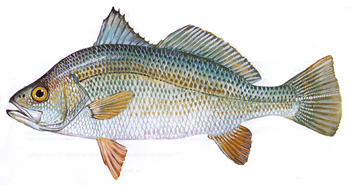
Silver Perch
- Silver Perch are inshore fish
- Average Size: Less than 1/2 lb, 6"- 8", Max size: 1 lbs, 12"
- Food quality: Good. They are often pan-fried
- Angling: Caught at or near the bottom while fishing with live and cut baits such as fish, clams, shrimp, and worms.
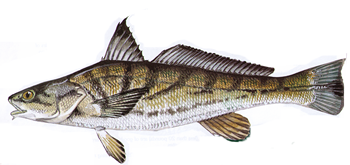
Southern Kingfish (Whiting)
- Southern Kingfish is more commonly known as whiting.
- Average Size: Less than 1/2 - 1lb, 6"- 10", Max size: 3 lbs, 20"
- Food quality: Excellent. They are often pan-fried
- Angling: Caught primarily surf or pier fishing with live or cut baits including shrimp, worms and fish

Gulf Kingfish (Whiting)
- Gulf Kingfish is also more commonly known as whiting.
- Average Size: Less than 1/2 - 1lb, 6"- 10", Max size: 3 lbs, 20"
- Food quality: Excellent. They are often pan-fried
- Angling: Caught primarily surf or pier fishing with live or cut baits including shrimp, worms and fish

Northern Puffer
- Puffers, also called sea squab, blow-fish and sugar toads. The flesh is not poisonous as other puffers but its viscera (internal organs) can be. It puffs up to a round shape when threatened.
- Average Size: 1/2 lb, 8", Max size: 1.5 lbs, 14"
- Food quality: Excellent. Avoid the internal organs.
- Angling: casting small hooks baited with shrimp.
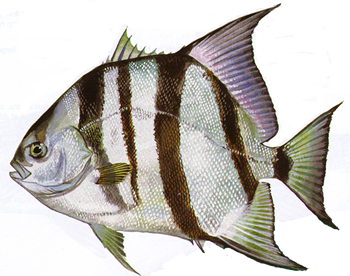
Atlantic Spadefish
- Spadefish can be found May through November nearshore from sandy beaches to reefs and harbors. Often found in large schools close to natural or man-made structures.
- Average Size: 1 - 3lb, 12"- 18", Max size: 20 lbs, 36"
- Food quality: Excellent. Mild, firm, white flesh
- Angling: Use small gold hooks baited with clam, shrimp or cannon ball jellyfish.

King Mackerel
- King Mackerel are in coastal waters from late spring to early fall.They like warmer waters and generally migrate below Florida in the winter.
- Average Size: 11 - 30 lb, 30" -45" , Max size: more than 100 lbs, 5.5 ft"
- Food quality: Good
- Angling: Can be caught at end of fishing piers using a floating method of live Atlantic Menhaden or cigar minnows.

Spanish Mackerel
- Spanish Mackerel are in coastal waters from April through October. They like waters above 68 degrees but when waters get too warm, above 80 they tend to favor cooler, deeper waters.
- Average Size: 2 - 3lb, 12"- 20", Max size: 13 lbs, 36"
- Food quality: Excellent.
- Angling: Primarily by trolling and drift fishing with natural baits and artificial lures and regularly taken from piers using Spanish Mackerel (Sabiki style) jigs.

Spot
- Spot get their name from the distinctive dark spot near it's gill opening
- Average Size: 1/2 lb, 6"- 8", Max size: 2 lbs, 12"
- Food quality: Excellent. Generally pan-fried
- Angling: Primarily caught during the fall months when larger adults migrate from northern areas. Best bait are blood worms, but can be caught on red worms, shrimp and cut bait.

Spotted Seatrout
- Spotted Seatrout are most abundant September through July.
- Average Size: 1 - 2 lb, 12"- 20", Max size: 15 lbs, 36"
- Food quality: Excellent.
- Angling: Primarily caught by trolling, jigging, surfcasting, and fly fishing with both natural and artificial baits. Live shrimp is best.
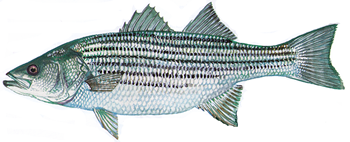
Striped Bass
- Found in major freshwater rivers in South Carolina, striped bass are also common along coastal inshore environments. Not normally caught from ocean piers.
- Average Size: 5 - 10 lb, 18"- 36", Max size: 78 lbs, 60"
- Food quality: Excellent. White, flaky, freezes well.
- Angling: Trolling, jigging, bait fishing, surf casting with natural and artificial baits.

Southern Flounder
- Southern Flounder prefer sandy and live bottom areas around pilings, jetties, oyster bars, and in high current areas.
- Average Size: 2 - 3 lb, 16"- 20", Max size: 20 lbs, 36"
- Food quality: Excellent with white firm flesh
- Angling: Drift fishing or casting with natural baits such as mud minnows, strips of cut bait, and pieces of blue crab or artificial baits such as buck tails, small spoons and spinners.
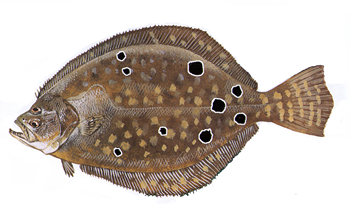
Summer Flounder
- Summer Flounder can be found in inshore and offshore burrowing in the sandy bottom.
- Average Size: 1.5 lbs, 14.5", Max size: 26 lbs, 36"
- Food quality: Excellent
- Angling: Drift fishing or casting with natural baits such as mud minnows, strips of cut bait, and pieces of blue crab or artificial baits such as buck tails, small spoons and spinners.

Skate
-
Although it has a similar body shape, a skate is not a stingray. It does not have a stinger on its tail. More than 200 species exist and can be found world-wide. They can live up to 100 years.
- Average Size: 3 lbs. 12" - 20" Max size: 8 feet, 200 lbs.
- Food Quality: Not generally eaten in the US
- Skates are caught when angling for other fish. They can be caught using live or cut bait and hooked while jigging.
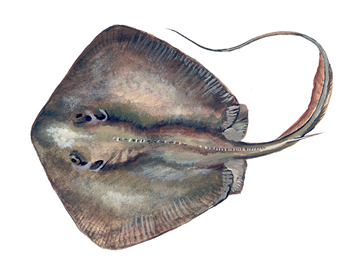
Stingray
- Similar body shape to a skate, the stingray has a barb with venom toward the base of its tail. Not at its tip as is commonly believed. More than 220 species exist and can be found world-wide. Generally live up to 25 years.
- Size: Depends on species. From 24" across to more than 23 feet across and up to 900lbs.
- Food Quality: Not generally eaten in the US
- Rays are caught when angling for other fish. They can be caught using live or cut bait and hooked while jigging.

Tarpon
- Tarpon avoid colder water. Very seldom is a tarpon caught from a pier but it's not unknown.
- Average Size: 40 - 50 lbs, 40" - 60" Max size: 150 lbs, 96"
- Food quality: Poor. Generally not eaten
- From a pier, tarpon have been caught by floating live bait.

Threadfin Shad
- Threadfin Shad are found in shallow coastal waters as well as larger rivers and reservoirs.
- Average Size: 1oz. 2" - 3" Max size: 3oz.
- Food quality: Poor. Generally not eaten
- Threadfin shad are used primarily as bait for other fish and can be caught on sabiki rigs.

Tripletail
- Tripletail lives in coastal waters up to depths of 20 feet. They can swim or float on their sides.
- Average Size: 3 lbs. 12" - 20" Max size: 50 lbs. 36"
- Food Quality: Excellent
- Tripletails are caught on natural baits like shrimp as well as artificial lures.